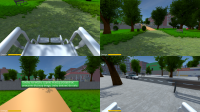Play to understand
An unusual game has been developed at the WUT Faculty of Mechatronics, enabling the player to travel around the city on a wheelchair. The goal of the app is to make the able-bodied aware of the difficulties that disabled persons have to face every day in the urban space.
The game was created by Artur Petrzak, a Mechatronics graduate and a programming enthusiast. He developed the multimedia app as part of his diploma project. The project was supervised by Sławomir Paśko, PhD, Eng., who himself devotes a part of his research work to the health-related issues. “The supervisor encouraged me to prepare something more advanced than a simple project required for an engineer’s thesis. I changed my original plans and decided to create something that may bring benefits to people in real life,” says the newly graduated engineer.
Early on in the project, people with disabilities were asked about various architectural barriers they encountered on an everyday basis. Then the programming work started, which involved creating the framework of the application. The author of the thesis says he derived most satisfaction from writing smart, well-structured algorithms.
The game is based on the Unity engine, one of the several popular graphic environments. Unity has a large community of developers who share various kinds of models and textures. These elements were used to build the game world.
The story is based on a simple idea. The player goes around the city on a wheelchair. He encounters various architectural obstacles corresponding to the barriers faced by the disabled in real life. In a standard game, the user would probably have to accomplish some abstract mission, but in Artur Petrzak’s application the tasks are not complicated. This is intentional – the purpose of the game is to make able-bodied persons aware of how challenging it is for people with physical disabilities to deal with stairs, curbs and lack of ramps.
“Things have been changing for the better. In accordance with the universal design concept, different kinds of barriers are eliminated, the public space is becoming available for everybody, including elderly people or parents with children,” says Małgorzata Żbikowska, specialist from the Section for the Disabled, who herself uses a wheelchair. She adds, however, that narrow aisles in stores, sidewalks blocked by cars and jam-packed trams during rush hours are also a serious problem. The solution, she argues, is to educate people. “The game could be successfully used in schools. Children are much more open to the issue of disabilities than adults. If they are exposed to this topic at an early age, they will develop a mature attitude as adults. If we want to change the physical space, we need to change the mentality first.”








